End Of The World Pickle
By Mike on Thursday, December 13, 2012, 22:12 - Permalink
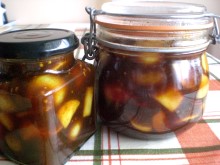 December 13, 2012 - The world is about to end! Oh Noes!
December 13, 2012 - The world is about to end! Oh Noes!
Time for action - I thought I'd make something that can't be used until 2013 - to tangibly demonstrate how seriously I take these prophecies of doom.
This is End Of The World Pickle.
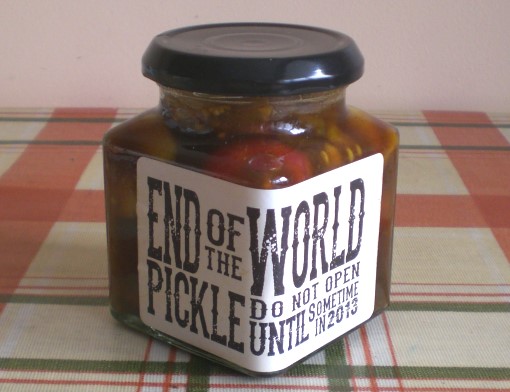
The Recipe
Ingredients:
- 250g small pickling onions
- 1 Large carrot
- 100g Dried apricots
- 75g Stoned dates
- 2 Small apples
- 200ml Malt vinegar
- 200ml Cider vinegar
- 200g Dark brown sugar
- A thumb-sized piece of fresh root ginger (about 20g)
- 2 Teaspoons ground mixed spices (if you can't find ready mixed spices, this should be a blend of allspice, nutmeg, cinnamon, ground coriander seed and cloves)
- 1 teaspoon whole mustard seeds
- 1 Teaspoon curry powder
- Half teaspoon chilli flakes (or more, if you want it extra spicy)
- Salt and water (see recipe)
Pickle, Chutney?
This is a jar of chunky pickled vegetables - in the UK, a coarse-textured pickle of this kind would often be called a chutney - originally a South Asian or Indian condiment, but now firmly adopted in Europe.
I wanted this one to be dark, sweet-sour, sticky and crammed with big chunky fruit and vegetables. Dark and enigmatic - with mysterious onions...
I'm anticipating that this will be mature enough to open sometime in 2013 - perhaps in the summer, alongside bread and good cheese for a picnic, or maybe I can hold out until Christmas and serve this with cold meats on Boxing Day.
If you fancy making your own jars of End Of The World Pickle, and want to use my label design, here's a link to a high resolution version of it (right-click and Save As).
Variations
If you can't find small pickling onions, shallots would be a good substitute - or perhaps small onions just carefully quartered.
The spice blend here is pretty much a classic British chutney blend, but you could adapt this to include more chilli (if you like things hot), or use whole spices such as cinnamon sticks and cloves, for visual effect - and to provide a variety of diffused flavours throughout the pickle.
Different spices (lemongrass maybe) and different vegetables and fruits (turnips or pears perhaps) could be used - just remember to add those that need longest cooking first, and the more delicate ingredients nearer the end.
Method:
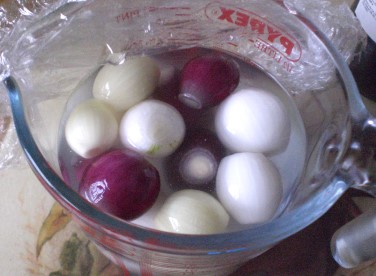 Top and tail the onions and peel away the papery outer skins.
Top and tail the onions and peel away the papery outer skins.
Soak overnight in brine made from 1 tablespoon of salt to every 400ml water.
 Brining the onions like this draws out some of their juices, leaving them ready to soak up the pickling liquor - which is essential for pickling them whole. I used a blend of robust malt vinegar and fruity cider vinegar for this pickle - 400ml in total.
Brining the onions like this draws out some of their juices, leaving them ready to soak up the pickling liquor - which is essential for pickling them whole. I used a blend of robust malt vinegar and fruity cider vinegar for this pickle - 400ml in total.
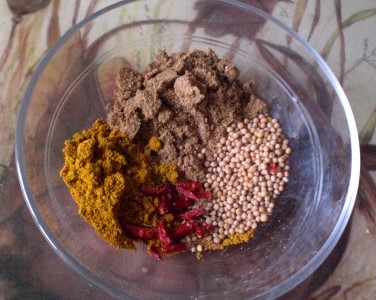 Other vinegars could be used instead, although white distilled (spirit) vinegar is considerably stronger and more acidic - if you use white vinegar, dilute 50/50 with water or apple juice. Spices - I was aiming at a classic chutney flavour, with a bit of a kick.
Other vinegars could be used instead, although white distilled (spirit) vinegar is considerably stronger and more acidic - if you use white vinegar, dilute 50/50 with water or apple juice. Spices - I was aiming at a classic chutney flavour, with a bit of a kick.
 So I used ground mixed spices (AKA 'Pudding spice' - this is a blend of coriander seed, cinnamon, nutmeg, allspice, cloves and ginger), fortified with a bit of curry powder, some dried bird chillies and mustard seeds.Add the vinegar, sugar and spices to a large pan and bring slowly to the boil, stirring to dissolve the sugar and infuse the spices.
So I used ground mixed spices (AKA 'Pudding spice' - this is a blend of coriander seed, cinnamon, nutmeg, allspice, cloves and ginger), fortified with a bit of curry powder, some dried bird chillies and mustard seeds.Add the vinegar, sugar and spices to a large pan and bring slowly to the boil, stirring to dissolve the sugar and infuse the spices.
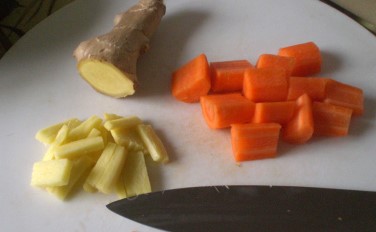 Adjust the heat so that the whole thing is just on a gentle bubbling simmer - you may need to turn the heat up and back down again each time the cold ingredients are added. The vegetable and fruit contents of the pickle need to be added in strict order - as some of them require more cooking than others.
Adjust the heat so that the whole thing is just on a gentle bubbling simmer - you may need to turn the heat up and back down again each time the cold ingredients are added. The vegetable and fruit contents of the pickle need to be added in strict order - as some of them require more cooking than others.
So, first up, the root ginger - peeled and cut to thick matchsticks and the carrot - peeled, halved lengthways and cut into 2cm chunks.
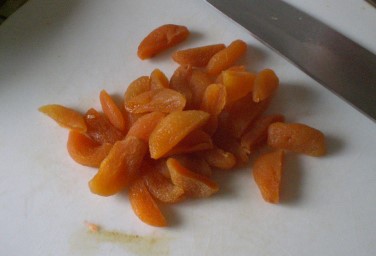 Put these in the hot pickling liquor and simmer them for three minutes - meanwhile, start preparing thr next item.Halve the apricots and dates (but don't cut anything too small - this is meant to be a really chunky pickle.
Put these in the hot pickling liquor and simmer them for three minutes - meanwhile, start preparing thr next item.Halve the apricots and dates (but don't cut anything too small - this is meant to be a really chunky pickle.
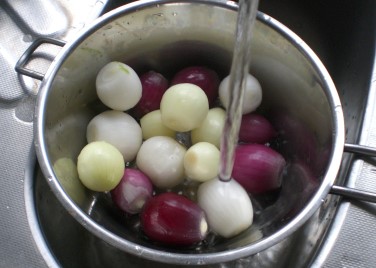 Once the carrots have had their three minutes simmering - add the apricots and dates to the pan - and start work on the next step.Drain and rinse the onions.
Once the carrots have had their three minutes simmering - add the apricots and dates to the pan - and start work on the next step.Drain and rinse the onions.
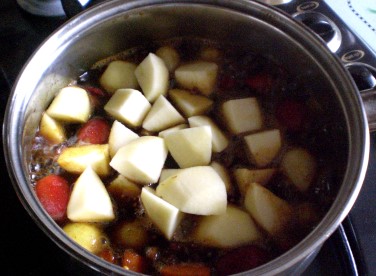 Add these to the pan (after the fruit has simmered for three minutes), then start work on the apples.Peel and chop the apples into 3cm chunks.
Add these to the pan (after the fruit has simmered for three minutes), then start work on the apples.Peel and chop the apples into 3cm chunks.
When the onions have had their three minutes, add the apples to the pan.
Now you need to stir gently and watch carefully. Once the apples just begin to soften, remove the pan from the heat.
 This will take between one and three minutes - depending on the hardness of the apples. I used small Cox's Orange Pippins, so it took about two minutes for them to soften a little.Using a slotted spoon, transfer the chunks of fruit and vegetables into jars - pushing it all down gently with a tablespoon to ensure good packing.
This will take between one and three minutes - depending on the hardness of the apples. I used small Cox's Orange Pippins, so it took about two minutes for them to soften a little.Using a slotted spoon, transfer the chunks of fruit and vegetables into jars - pushing it all down gently with a tablespoon to ensure good packing.
 Don't worry if you can't find the dates - it's normal for them to have dissolved into the pickling liquor, turning it dark and syrupy.Spoon the pickling liquor into the jars, topping them up as far as reasonably possible - but ensuring that all of the solid ingredients are covered.
Don't worry if you can't find the dates - it's normal for them to have dissolved into the pickling liquor, turning it dark and syrupy.Spoon the pickling liquor into the jars, topping them up as far as reasonably possible - but ensuring that all of the solid ingredients are covered.
It's a good idea to give the contents of the jars a little poke and stir with the handle of a spoon as you add the liquid, as this will make sure there are no trapped pockets of air in the jar.
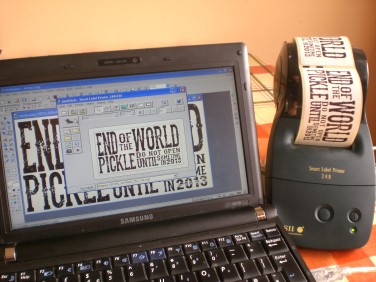 Seal down the lids while the pickle is still hot.Finally, label the jars - I made a fun retro-vintage style label for mine.
Seal down the lids while the pickle is still hot.Finally, label the jars - I made a fun retro-vintage style label for mine.
But all joking aside, it's quite important to label pickles and chutneys - as they need to be left to mature before consuming - this one will be ready sometime around the middle of 2013.
However, like fine wines, some pickles continue to improve with age - I once discovered a forgotten, unopened jar of apple and elderberry chutney (in a box that I thought contained only empty jars) that I had made seven years earlier - it was extraordinarily good - this is another good reason to label the jars.
